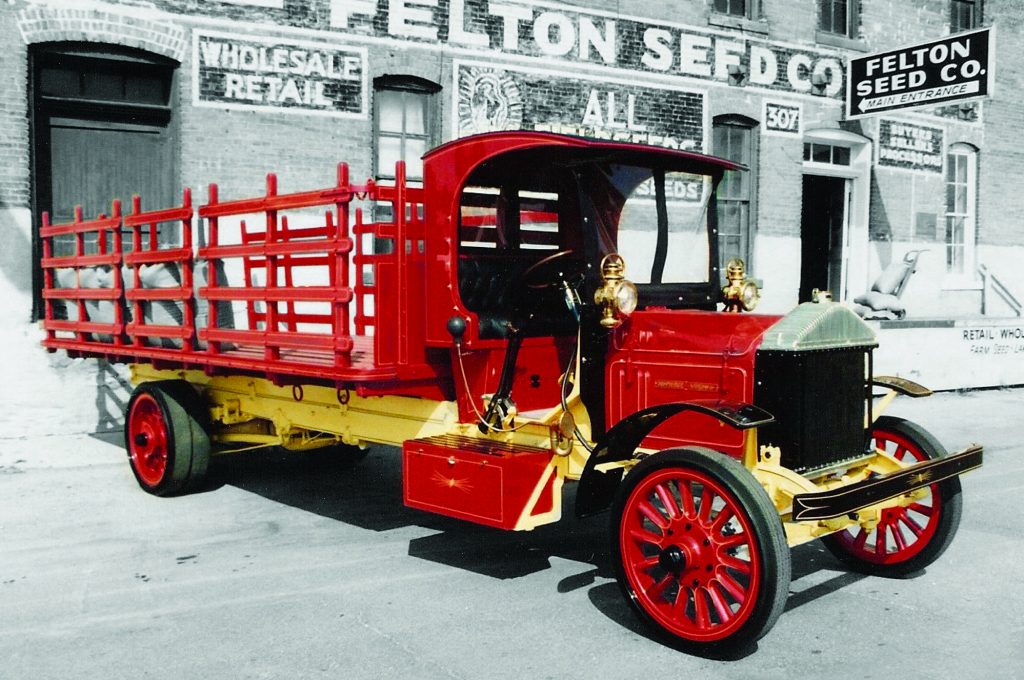- Home
- About Us
- Join/Renew
- Member Benefits
- Member Pages
- Log In
- Help
- Museum Store

After years of discussion and planning, the first Pierce-Arrow truck was shown in January, 1911. The five-ton stake-bed truck featured a worm-drive rear axle and hard rubber tires. The Pierce-Arrow worm-drive trucks were quieter and more reliable than the chain-drive mechanism used by most trucks of the time. The first Pierce-Arrow truck, the X-1, had a four-cylinder T-head engine with 4 7/8″ bore and 6″ stroke. The truck had three forward speeds and sold for $4500. The Pierce-Arrow truck set a new standard for trucks made in America. The X-1 was augmented by a two-ton model, the X-2 in 1913.
These X-1 was replaced by the R-5 in 1915. The quality of the Pierce-Arrow truck was recognized by the the military powers of World War I. Pierce-Arrow delivered over 14,000 trucks to the French and British governments by the end of the War.
In 1923, the truck line underwent it’s first major overhaul since the first truck was introduced in 1911. The 1923 trucks were now available in six models ranging from 2 1/2 tons to 7 1/2 tons. All trucks used a dual-valve four-cylinder engine. The top of the line, the Model R-F sold for $5,400.
In 1924, the Model Z was introduced. The Model Z used the Series 33 passenger car Dual-Valve Six engine and came with a 196″ or 220″ wheelbase. Primarily intended as a bus chassis, many Model Z chassis were fitted with other bodies such as fire truck, moving van, and tanker bodies. Pierce-Arrow claimed a top speed of 60 miles per hour.
In 1928, another chassis was added to the truck line. The Fleet Arrow Wagon, Model FA, used a modified Series 81 passenger car engine. Mounted on a 140, 160, or 180 inch wheelbase, the Fleet Arrow was primarily intended for inner-city delivery service. The Fleet Arrow could be ordered with either single or dual rear wheels equipped with pneumatic tires. The brakes applied to all four wheels plus the drive shaft. Houdaille hydraulic shock absorbers were supplied on the front axle. Pierce-Arrow advertised a top speed of 49 miles per hour using 34 inch tires and a 5 2/7:1 rear axle ratio. Unlike earlier Pierce-Arrow trucks, the Fleet Arrow did not use a worm-drive rear axle. Production of the Fleet-Arrow ceased in 1929 after slightly over 500 were made.
After over a year without any truck production, a new line of Pierce-Arrow trucks were introduced in late 1930. The four models ranged from the 70-horsepower, 2-ton model PT to to the 130-horsepower, 8-ton model PZ. All trucks used a six-cylinder engine specifically produced for the trucks. In late 1932, all truck production at Pierce-Arrow was ceased. The Studebaker Corporation, who owned controlling interest in Pierce-Arrow, shifted all truck production to the White Motor Corporation. Trucks with the Pierce-Arrow name continued to be available from White until 1935.
Pierce-Arrow also supplied 8 and 12 cylinder engines to the Seagrave Corporation for use in fire engines. These engines continued to be made even after Pierce-Arrow ceased operation in 1938. Seagrave continued to deliver fire apparatus with the “Pierce-Arrow” V-12 until 1970.
Pierce-Arrow’s final attempt at the commercial market was in 1935 when they made some 9 and 15 passenger sight-seeing buses.
